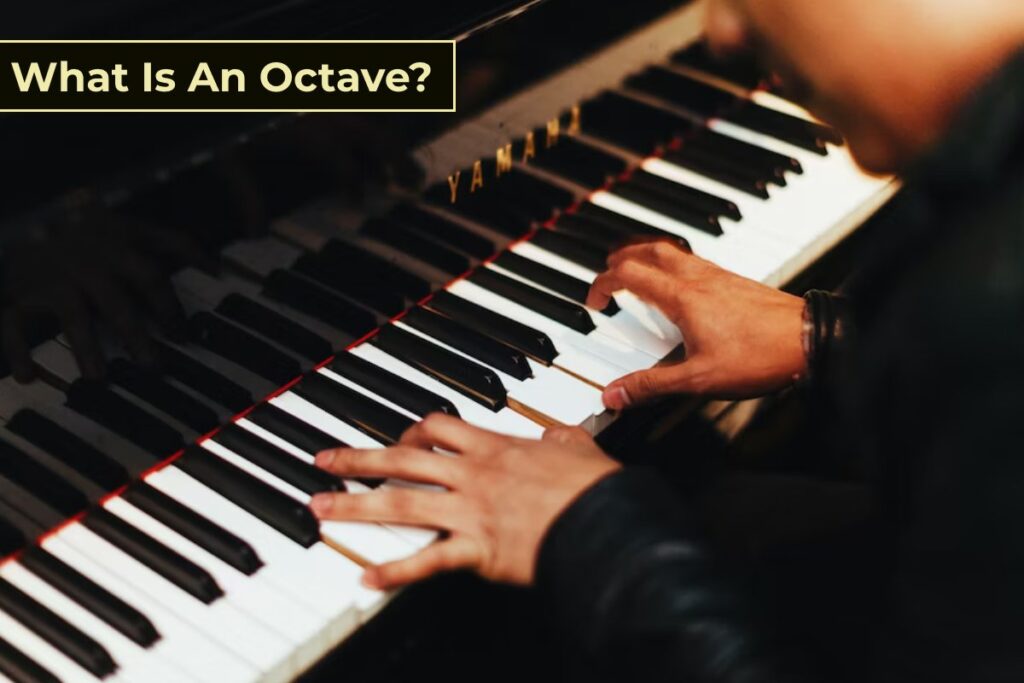A Complete Guide To What Is An Octave In Music

An Octave in Music
There are numerous valid ways to answer the question “What is an octave?” Each approach provides unique insights and perspectives, contributing to a comprehensive understanding of this musical concept.
An octave is a fundamental concept in music, an enchanting interval that holds a special place in our musical experiences.
Understanding the essence of an octave is key to unlocking the mysteries of melody, harmony, and musical expression. This aspect of music is useful for every musician, music enthusiast, or anybody who is simply curious about the mechanics of sound.
In this article, we will delve into the captivating world of octaves, exploring their definition, significance, and the remarkable role they play in shaping the beauty of music.
So, let’s embark on a journey to discover the true nature of an octave and unravel its enchanting secrets.
What is an octave?
An octave is the interval between two notes that have the same name but are one octave apart. In western music, the octave refers to the interval spanning eight notes up and down the scale, such as from C to the C above or below.
For example, the note D4 played on a piano is one octave above the note D3, and the note D2 is one octave below the note D3.
Furthermore, an octave refers to the interval between two pitches where the higher pitch has a frequency exactly double that of the lower pitch.
The interval between two notes separated by an octave encompasses 13 distinct notes, each separated by 12 semitones or 12 half-steps.
This significant pitch distance results in the higher note doubling the frequency of the lower note.
Primarily, the octave is the most consonant interval in music, and it is often used to create a sense of closure or finality.
How are Octaves Created?
In physics, the interval known as an octave occurs when the frequency of a second note is precisely double that of the first note.
So, octaves are created when two notes have a frequency ratio of “two to one,” or 2:1.
This means that the higher note vibrates twice as fast as the lower note.
For example, the note C played on a piano vibrates at 261.63 Hz, while the note C played an octave higher vibrates at 523.26 Hz.
Furthermore, let’s consider the note A4, which vibrates at a frequency of 440 Hz.
On the other hand, the note A5 resonates at a frequency of 880 Hz, exactly twice that of A4. It means note A5 is an octave higher than note A4.
Similarly, when we descend in pitch, the note A3 corresponds to a frequency of 220 Hz, precisely half the frequency of A4, which is 440 Hz. This means that the note A3 is an octave lower than the note A4.
This relationship between frequencies emphasizes the fundamental nature of octaves in music. It shows how they generate distinct tonal variations while maintaining a consistent harmonic connection.
Understanding this principle is vital to grasping the intricate relationships between different musical pitches and their harmonic properties.
Octave Division in Music
In Western music, we divide octaves into 12 equal intervals, with each interval representing a different note. These intervals in the C major scale are as follows:
| Step | Note |
| Keynote or Tonic | C |
| 1st half-step | C# / Db |
| 2nd half-step | D |
| 3rd half-step | D# / Eb |
| 4th half-step | E |
| 5th half-step | F |
| 6th half-step | F# / Gb |
| 7th half-step | G |
| 8th half-step | G# / Ab |
| 9th half-step | A |
| 10th half-step | A# / Bb |
| 11th half-step | B |
| 12th half-step | C |
The notes with slashes allow us to use either name, depending on the key we are in. Specifically, these notes are called enharmonic notes.
For example, in the key of D, the note F# serves as the third interval in the D major scale.
However, in the key of Eb minor and the Eb minor scale, that exact pitch is referred to as Gb, in accordance with the rules of music theory.
Using these notes, we can actively move stepwise up or down an octave in the following ways:
Moving from the note G to the note Ab, advancing by one interval at a time, is actively known as moving in half steps (or semitones).
Moving from the note G to the note A, advancing by two intervals at a time, is actively known as moving in whole steps (or whole tones).
Note
The interval between two notes separated by an octave encompasses 12 semitones or 12 half-steps.
This significant pitch distance results in the higher note doubling the frequency of the lower note.
Comprehending the concept of an octave and its numerical relationship of 12 semitones holds crucial importance in music theory.
This concept establishes the foundation for a wide range of harmonic and melodic patterns.
By understanding this fundamental interval, musicians and music theorists can navigate the extensive realm of musical scales, chords, and progressions with precision and clarity.
Octave in the Music Scale
When tones have different pitches, they create distinct sounds. The distance between these tones in terms of pitch is called an interval.
Among the various intervals, the octave holds special significance. When tones are an octave apart, they exhibit a remarkable similarity in sound.
When played together, two tones separated by an octave blend harmoniously, almost merging into a single tone.
The interval of an octave plays a crucial role in music. It defines the distance between the first and last tones of a well-known scale.
The interval of an octave plays a vital role in music as it defines the distance between the first and last tones of a well-known scale.
Let’s sing the scale of C major out to gain a clearer understanding.
| Degree | I | II | III | IV | V | VI | VII | VII |
| Note | C | D | E | F | G | A | B | C |
| Solfege | Do | Re | Mi | Fa | So | La | Ti | Do |
As you sing the scale of C major, you will observe that it encompasses the span of an octave.
Starting from the low do, you traverse the octave by vocalizing seven distinct pitches until you reach the high do, which replicates the initial low do.
Unlike a sliding siren, you ascend the octave by precisely hitting specific pitches rather than continuously gliding between them.
This collection of seven tones has served as the cornerstone of music in western civilization for centuries.
The white keys on a piano keyboard beautifully generate these seven tones, as depicted in the accompanying illustration.
Each pitch within this octave carries a unique role in crafting melodic and harmonic structures, contributing to the vibrant tapestry of musical expression.
Octave in scale Degree
| Notes | Scale Degree | Degree Name |
| 1st note of the scale | Scale degree I | Tonic |
| 2nd note of the scale | Scale degree II | Supertonic |
| 3rd note of the scale | Scale degree III | Mediant |
| 4th note of the scale | Scale degree IV | Subdominant |
| 5th note of the scale | Scale degree V | Dominant |
| 6th note of the scale | Scale degree VI | Submediant |
| 7th note of the scale | Scale degree VII | Leading Tone |
| 8th note of the scale | Scale degree VIII | Tonic (Octave) |
While the notations “8th degree” and “VIII” are commonly used to represent the octave, it is important to recognize that the octave is essentially a higher-pitched version of the tonic, or the first degree of the scale.
It is not a distinct degree in itself, but rather a continuation of the musical scale. The octave maintains the same fundamental tonal qualities as the tonic, but with a noticeable difference in pitch.
What are the Different Types of Octaves?
In music, the concept of octaves extends beyond the basic definition of an interval between two notes that are double or half the frequency of each other.
There are several different types of octaves that musicians and composers encounter. Here are some notable examples:
Perfect Octave
The perfect octave is the most common type of octave.
It refers to the interval between two notes that have the same name and sound identical, but with one note being exactly eight diatonic scale degrees higher or lower than the other.
Perfect octaves have a consonant sound.
A perfect octave refers to the interval between two notes where the note name and accidental of the top note are identical to the bottom note.
This interval occurs when the interval between two notes is eight scale degrees.
Besides, what distinguishes the interval as a perfect octave is the presence of a matching accidental.
Diminished Octave
A diminished octave is an interval that is smaller than a perfect octave.
It occurs when the higher note is lowered by one or more semitones compared to the lower note.
Diminished octaves are less common, and they have a dissonant sound.
In the context of music, to diminish something means to make it smaller.
When we talk about a diminished octave, it refers to an interval where the top note is lowered by a half step compared to a perfect octave.
It is important to note that the note names of the two tones in a diminished octave remain the same. If the note names were different, we would not have an octave anymore.
The distinction lies in the accidental attached to the top note, which indicates that it has been lowered by a half step.
This alteration creates a unique tonal quality and adds a sense of tension or dissonance to the musical passage.
Augmented Octave
An augmented octave is an interval that is larger than a perfect octave.
It occurs when the higher note is raised by one or more semitones compared to the lower note.
In music, augmentation refers to increasing the pitch of a note. In the case of an augmented octave, we raise the top note by a half step in comparison to a perfect octave.
However, even with this adjustment, we keep the note names unchanged. It is vital to preserve the same note names in order to recognize the interval as an octave.
We achieve an augmented octave by introducing an accidental to raise the top note by a half-step.
These various types of octaves add depth and complexity to musical compositions. It allows for diverse tonal colors and harmonic possibilities.
Musicians and composers leverage these octave variations to create unique and expressive musical experiences.
How are Octaves Used in Music?
Octaves are extensively used in music for various purposes and serve different functions.
For instance, they can be used to create a sense of closure or finality, as in the final chord of a song. They can also be used to create a sense of harmony, as in the melody and harmony of a song. Additionally, octaves can be used to create a sense of rhythm, as in the beat of a song.
Below are some common ways in which octaves are employed:
- Doubling
- Harmony
- Bass Lines
- Register Shifting
- Transposition
- Counterpoint
Doubling
Octaves are often used to double a melody or a vocal line. By playing or singing the same melodic line one or more octaves higher or lower, it creates a fuller and richer sound.
Harmony
Octaves are fundamental to creating harmony. Chords played with notes that are an octave apart can produce a strong and powerful sound, adding depth and resonance to the overall harmonic structure of a composition.
Bass Lines
Octaves play a significant role in bass lines. A bass guitarist or a bass instrument often plays the root note of a chord in a lower octave, providing a solid foundation and enhancing the overall rhythmic and harmonic elements of a piece.
Register Shifting
Octaves can be used to shift the register of a melody or a musical phrase. Moving a melody or a phrase up or down by an octave can bring about a change in mood, intensity, or character, adding variation and interest to the music.
Transposition
Octaves are instrumental in transposing music. When a piece of music is transposed to a different key, all the notes are shifted by the same interval, usually an octave. This allows the music to be played in a different key while maintaining the same melodic and harmonic relationships.
Counterpoint
Octaves play a role in counterpoint, which is the combination of multiple melodic lines. Octave intervals between different voices or instruments can create parallel movements and harmonious interactions between the voices.
Overall, octaves are an essential component of music theory and composition. They provide versatility, depth, and harmonic structure to melodies, harmonies, and overall musical arrangements.
Famous examples of octaves in music
There are numerous famous examples of octaves used in music across various genres and styles.
One example is the opening of Beethoven’s Fifth Symphony.
Beethoven’s Symphony No. 5
The iconic opening motif of Beethoven’s Fifth Symphony features two repeated notes played in octaves, creating a powerful and recognizable theme.
Specifically, the first four notes of the symphony are all octaves, and they create a powerful and dramatic opening.
Mozart’s Symphony No. 40
In the first movement of Mozart’s Symphony No. 40, there are several instances where the melody is played in octaves, adding depth and richness to the composition.
Another example is the final chord of Mozart’s “Eine Kleine Nachtmusik.” The final chord is an octave, and it creates a sense of closure and finality.
Chopin’s Revolutionary Étude

Chopin’s Étude Op. 10, No. 12, also known as the Revolutionary Étude, includes dramatic octave passages that showcase the composer’s virtuosity and intensity.
The challenge presents itself in the relentless left hand semiquavers, while the right hand skillfully shapes widely distributed octaves into smooth melodic phrases.
The ascending forte dotted rhythms of the octave melody, combined with the continuous tumultuous accompaniment in the left hand. This creates a dramatic and intense musical experience with only a few moments of respite.
Queen’s “Bohemian Rhapsody”
The famous rock ballad by Queen includes octave harmonies in the vocal arrangement, particularly in the iconic “Galileo” section, creating a powerful and anthemic sound.
Bach’s Toccata and Fugue in D minor
The Toccata starts with a single-voice flourish in the higher octaves of the keyboard, doubling it at the octave and adorning it with a lower mordent. Then, it spirals down towards the lower range, reaching its culmination with the introduction of a diminished seventh chord.

This masterpiece by Johann Sebastian Bach also organ passages that utilize octave pedal tones, creating a deep and resonant bass foundation.
These examples highlight how octaves are used to add emphasis, create harmonies, provide melodic support, and contribute to the overall texture and impact of the music.
Final Thoughts
Octaves are a fundamental building block of music, and they can be found in all genres of music.
They are an important part of music. They are used to create a variety of effects, including closure, harmony, rhythm, and power.
Understanding the concept of the octave is vital for grasping the patterns and structure of music.
It enables us to recognize the recurring relationships between scale degrees, highlighting their harmonic and melodic connections.
The octave acts as a unifying element, bridging different registers and providing a sense of coherence and completeness within a musical composition.
Moreover, the octave offers musicians and composers a wide range of tonal possibilities.
By exploring different octaves, they can create variations in pitch and timbre, add depth and richness to melodies, and evoke contrasting emotions within a piece of music.
The manipulation of octaves allows for the creation of melodic and harmonic tension and release, as well as dynamic and expressive musical phrases.
At Phamox Music, we go all out for exactness and honesty. For this purpose, if by any means you found any possible glitch, be it factual, editorial or something that we need to update, kindly contact us.
If you find the information provided in this post, What is an Octave, interesting and helpful, kindly share it with someone you know who might need it.







